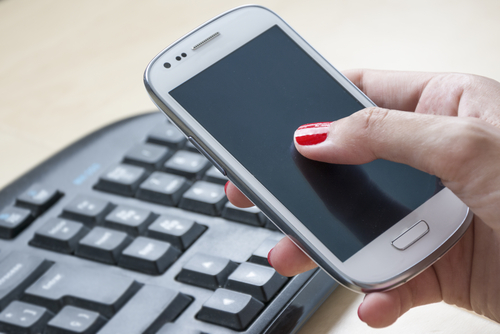September 17th, 2013

With the impending release of Apple’s latest version of their operating system, iOS7, users will be prompted to upgrade their phone to gain access to new features. The release of new operating systems usually is synonymous with the addition of bugs and issues. Samantha Murphy Kelly, of Mashable, writes that before you upgrade, you should back-up all of your data.
There are already some users who have gained access to iOS7 and have reported no problems. However, it’s a good idea to back-up your phone periodically and ahead of a major update is a great time for some piece of mind. This way, you aren’t risking anything by upgrading.
If you’re currently using iOS5 or iOS6, your iPhone will automatically back-up data to the iCloud, but you must first enable this feature. To do that, go to ‘Settings’, select ‘iCloud’ and then ‘Backup & Storage’. Once you’ve done this, your iPhone will back up your data daily, as long as it’s plugged in and connected to WiFi with the screen locked.
Even with this option enabled, you’ll want to back up manually before upgrading your OS. By following the same steps as before, but selecting ‘Back Up Now’ your phone will back up your data right then and there. It’s a lengthy process so be prepared and the more data you have, the longer it will take.
One other issue you should resolve before updating to iOS7 is clearing some storage space. You’ll need space to update, so go ahead and get rid of seldom used apps, old photos and music you no longer want.
If you end up losing some of your data, call Geek Rescue. We have the tools needed to recover data for nearly any device. We also fix broken gadgets and get rid of viruses and malware infections. Call us at 918-369-4335 or come by Geek Rescue.
September 17th, 2013

The iPhone 5s will be released soon, which has security experts scrambling to figure out what flaws could be exploited by hackers. Because the new iPhone, and even its new operating systems, iOS7, haven’t been officially released, Matthew J. Schwartz made some educated guesses about possible security concerns at Information Week.
New operating systems usually make sure to shore up any security holes that previous versions may have had. In the iPhone’s case, the previous operating system was considered “a freaking vault” according to one security researcher. The concern then, is that any new operating system will have flaws of its own that are just waiting to be discovered.
A new processor also suggests new flaws to be exploited. But, the new processor promises to make previous exploits obsolete and reportedly makes jailbreaking, or gaining root access to the device through bugs, much more difficult.
Multiple security experts suggest the fingerprint scanner, or Touch ID, will draw most hackers attention initially. There have already been multiple suggestions about how to break through the new iPhone’s security measure.
One tactic, dubbed a “phish finger”, would be to take a finger print from the touch screen and use it to fool the fingerprint scanner. New technology is supposed to make it difficult to fool the scanner without an actual finger, but it can still be done.
Fingerprints of the iPhone’s owner are encrypted and stored on the device, so one theory is that these fingerprints could then be stolen and used to hack into the device. However, the way the fingerprints are stored makes them only recognizable to the iPhone’s processor, which means they can’t be exported to another device.
Touch ID isn’t the only security measure on the iPhone 5s. A password is still in place as well and is required in some situations.
There are certainly some security upgrades on the new iPhone, but there appears to be some potential vulnerabilities as well. In the coming days, more of these vulnerabilities will likely be revealed as more hackers and security experts have hands-on time with the iPhone 5s.
If you need additional security on your mobile device, be it a new or old iPhone, Android or other, bring it to Geek Rescue. We improve security, get rid of malware and fix broken hardware. Come by or call us at 918-369-4335.
.
August 29th, 2013

The most used mobile operating system in the world is Android. If you own an Android device, you’re also the most likely to be the victim of a malicious attack.
The BBC reports that Android users were 79-percent of attacks on mobile devices in 2012. Apple’s iOS, on the other hand, suffered less than 1-percent of attacks.
The simple fact that more users are available through Android than iOS plays a role in why hackers dedicate more time to that operating system. Another reason is chalked up to Android’s very architecture. The same thing that makes Android so developer friendly and customizable also makes it susceptible to malware.
There have been many security vulnerabilities exposed in older version of Android operating systems. Since many users are still using devices with those systems installed, they are still at risk. Apple, on the other hand, reports that more than 93-percent of their users have the latest operating system installed on their device.
Two key threats have been identified as the main sources of malware infections. One, Text trojans, sends unsolicited SMS messages to users containing harmful links. The other are fake sites that appear to be the legitimate Google Play store, but actually contain harmful apps.
Although older versions of the Android operating system are most at risk, newer version have displayed vulnerabilities as well. Recently, the so-called ‘Master Key’ bug allowed hackers in China to take control of a number of Android phones.
To keep your device safe, you need a combination of security apps and smart surfing practices. To increase the security on your device, be it Android, iOS, mobile or desktop, call Geek Rescue at 918-369-4335.
August 28th, 2013

Bring your own device, or BYOD, is a growing trend in business. It refers to employees using their own devices, like smartphones and tablets, to access their company’s network and make their jobs easier. This becomes a problem in terms of security.
As Anders Lofgren writes for All Things Digital, an estimated 80-percent of employees are already bringing their devices to the office but many employers aren’t embracing this trend. This doesn’t mean that workers will stop using their smartphones to check their work email. It does mean that they’ll be doing so in an unsecured manner.
The threat of data being lost is exponentially higher when there are no security mandates on employees devices. Just by password protecting a smartphone, you greatly reduce your risk. There’s also a need to ensure that any device accessing your network has adequate security software installed.
Beyond adapting to the growing BYOD trend, you should also have an eye on what’s ahead.
Bring your own cloud, or BYOC, is another employee habit companies must plan for. Using Dropbox, Google Drive or other public cloud services makes an employee’s job simpler, but there are a number of security concerns.
If you allow individuals to bring their own device to work, what happens when they leave the company? Take your own device, or TYOD, refers to the policy of remotely wiping a former employees device of any sensitive data specific to your company. Currently, less than a quarter of all businesses have a policy to ensure former employees don’t still have sensitive data on their personal devices.
Compatibility issues also become a major problem when employees bring their own devices. Many will have iPhones or iPads, which may not be immediately compatible with your companies software choices.
To lock down your security in the face of the BYOD trend, call Geek Rescue at 918-369-4335. We solve compatibility issues, close gaps in security and offer solutions to keep your business running efficiently.
August 26th, 2013

When your phone is stolen, there are a number of things to worry about beyond just getting a new phone. All of our smartphones carry personal information that is used to access our online accounts when it falls into the wrong hands. Before getting a new phone, our first concern should be to lock down access to our old phone.
As Jaeyeon Woo reports for the Wall Street Journal, Samsung and LG are taking measures to not only prevent smartphone theft, but also to keep your data safe after theft. Their new anti-theft tool, or “kill switch”, would completely disable a phone that’s been reported stolen. This means the device becomes inoperable, even with a new SIM card or hacking procedures.
A growing business overseas is to ship and sell stolen smartphones to the U.S. This “kill switch” feature would take a tremendous bite out of that industry. However, users will have to register their devices before they are stolen in order to use the kill switch function.
Samsung and LG’s efforts build on the recently publisized developments for Android phones to help find and lock lost and stolen phones. Those using iOS devices also have similar functions to protect their lost and stolen devices.
The kill switch, however, is seemingly the first tool that bricks a device in any circumstance. Since the phone is rendered useless, the hope is that thefts will drop dramatically. In any event, users won’t have to worry that the theft of their smartphone will also lead to the theft of their identity.
To keep your smartphone or other device more secure, contact Geek Rescue at 918-369-4335. We offer a variety of security options and also fix broken devices and devices with infected with malware.















